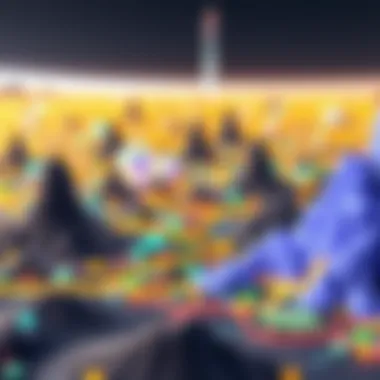Key Strategies for Identifying Valuable NFTs


Intro
Navigating the landscape of non-fungible tokens (NFTs) can be quite the adventure. The past few years have brought a whirlwind of digital collectibles into mainstream conversation, dazzling investors and collectors alike. With numerous projects arising daily, spotting the most promising NFT opportunities emands sharpened analytical skills and a strategic mindset. This requires not just surface-level understanding but a deep dive into various aspects that can influence value and potential return on investment.
As we unravel this intricate ecosystem, we will delve into multiple layers that define an NFT's worth. From understanding the technological foundations that power these assets to the subtle nuances of market trends, each topic is crucial. It’s more than just the art; it’s about the community, the underlying technology, and the overall market sentiment that can make or break an investment.
Key Concepts of Cryptocurrency
Grasping the basics of cryptocurrency is essential for anyone looking to invest in NFTs. The digital world has its own set of rules, and becoming familiar with these can set a solid groundwork for making informed decisions.
Understanding Blockchain Technology
At its core, the blockchain is a decentralized ledger that records all transactions across a network of computers. This technology not only provides transparency but also ensures that each NFT is unique and cannot be duplicated. Most NFTs are built on the Ethereum blockchain, although others like Binance Smart Chain or Solana are also gaining traction.
Understanding how blockchain functions is vital for investors. It allows for a better evaluation of the security, authenticity, and ownership of an NFT. It’s akin to knowing the foundation of a house before buying it; a strong foundation often means a sound structure.
The Role of Cryptographic Security
NFTs rely heavily on cryptographic techniques to secure ownership and transaction records, making them resistant to fraud. Each transaction is encrypted and linked to previous transactions, creating a chain that is almost impossible to break.
Investors must cozy up to the concept of wallets—both hot and cold—where their NFTs are stored. A hot wallet, for instance, is always online, making it more convenient but susceptible to cyber-attacks. On the other hand, offline cold storage offers better security but at the cost of accessibility. Understanding these nuances is crucial for protecting one’s digital assets.
Investment Strategies and Market Trends
Diving deeper into investment strategies helps sharpen your acumen for spotting the next big NFT. The market is dynamic, and while trends fluctuate, there are fundamental principles that guide strategic investment in this digital frontier.
Analyzing Market Dynamics
The NFT market isn’t just about buying and holding. One has to keep an eye on active listings, sales history, and major trends over time. Keep tabs on platforms like OpenSea and Rarible to monitor what's in vogue. Moreover, the rise and fall of cryptocurrency prices can also influence NFT values, so practitioners need to stay informed on broader crypto market movements.
Recent trends reveal shifts toward community-oriented projects, where token holders gain unique access or voting rights, thus increasing their intrinsic value. The importance of community connection and its potential impact on perceived value cannot be understated.
Risk Management in Crypto Investments
Every seasoned investor knows the phrase “Don’t put all your eggs in one basket.” This holds true in the volatile NFT space as well. When it comes to risk management, diversification is key. Investing in a variety of NFT projects can help mitigate risks associated with market fluctuations.
A sound strategy also includes setting limits on investment amounts and closely monitoring your portfolio. Keeping emotions in check can help avoid hasty decisions that are often driven by fear or greed.
"The key to successful investment lies in informed decision-making, not blind speculation."
In sum, this guide aims to arm you with the vital strategies necessary for navigating the captivating world of NFTs. By understanding the underlying technology, market dynamics, and effective risk management, you’re better positioned to make sound investments in a space that’s continually evolving.
For additional insights on blockchain technology and cryptocurrency trends, check resources like Wikipedia: Blockchain and Investopedia: Cryptocurrency.
With this foundation, the remaining aspects of evaluating NFTs and their market potential will only serve to enhance your investment approach.
The NFT Landscape
In understanding the world of Non-Fungible Tokens, or NFTs, it is paramount to grasp the current landscape that defines this digital phenomenon. The NFT landscape acts as a multi-faceted environment where art, technology, and culture intersect, offering opportunities for investors and creators alike. By exploring various dimensions — from the fundamentals of NFTs to their diverse categories — we set the foundation for strategic decision-making when investing in these unique digital assets.
What Are NFTs?
Non-Fungible Tokens are unique digital assets that represent ownership of specific items or content on a blockchain. Unlike cryptocurrencies such as Bitcoin or Ethereum, which are interchangeable, NFTs are distinct and cannot be exchanged on a one-to-one basis. This uniqueness allows for the verification of ownership and provenance, particularly important in the art world where authenticity is critical.
The mechanics of NFTs hinge on blockchain technology, predominantly Ethereum, which maintains a secure and tamper-proof ledger outlining the ownership history of each token. This has opened the door to various sectors including art, music, and gaming, creating new avenues for creators and collectors alike.
NFT Market Overview
The NFT market has experienced explosive growth, capturing the attention of traditional investors and digital enthusiasts. In recent years, sales volumes have surged, indicating a burgeoning interest that spans across demographics and industries. As of 2023, the market has expanded significantly, with platforms like OpenSea and Rarible leading the charge in facilitating NFT transactions.
This rise can be attributed to several factors, including the increased digitalization of assets, a growing community of creators, and mainstream media coverage. Notably, celebrities and renowned artists have launched their NFTs, further legitimizing and popularizing the concept. However, like any market, it is crucial to understand the fluctuations inherent in NFT prices, making a solid grasp of market trends vital for potential investors.
Diversity of NFT Categories
The landscape of NFTs is diverse, encompassing various categories that cater to different interests and collectors. Understanding these categories can illuminate potential investment opportunities.
Art


Art NFTs have gained significant traction within the crypto-collectible sphere, with long-standing artists and new creators alike utilizing platforms to mint their work. The key characteristic of art NFTs is their capacity to provide verifiable ownership of digital pieces, thereby supporting artists in monetizing their creations in ways previously unattainable.
A unique feature of art NFTs is the ability for artists to earn royalties on secondary sales, a beneficial aspect that has appealed to many creators. However, there's a flip side; markets can be speculative, leading to volatile prices that may deter investors looking for stability.
Music
Musical NFTs offer artists a novel way to distribute their work while potentially increasing their earnings. By bypassing traditional music distribution platforms, artists can sell their songs and albums directly to fans in NFT form. This creates a personal connection between creators and their audience, a characteristic that has garnered popularity.
The standout feature of music NFTs is the opportunity for exclusive content; holders may receive unique access to concerts or behind-the-scenes footage. But it's essential to note that the music NFT market is still emerging, and investors must navigate the uncertainty that comes with it.
Gaming
Gaming NFTs represent in-game items or assets that players can buy, sell, and trade. This has revolutionized how gamers interact with virtual worlds. With the rise of play-to-earn models, gamers can not only play for fun but also earn tangible rewards.
A distinctive quality of gaming NFTs is their utility in digital experiences; they are more than just collectibles. However, the market's young age and rapid evolution may pose risks for investors looking for immediate returns.
Collectibles
Collectibles in the form of NFTs have become hugely popular, allowing fans to own a piece of their favorite culture, be it sports memorabilia or digital trading cards. The intrinsic characteristic of collectibles is their nostalgic value, drawing in a wide audience and facilitating community engagement through trading and showcasing.
One advantage of collectibles is the emotional connection they foster; however, trends can change quickly, leading to potential declines in value if the market turns.
Evaluating NFT Investments
Evaluating NFT investments is a critical process for anyone looking to delve into the world of non-fungible tokens. As the market continues to evolve, understanding the dynamics behind NFT values can drastically influence the success of your investment decisions. Investors need to move beyond mere speculation and embrace a more analytical approach that includes market trends, project fundamentals, and community engagement. By doing so, investors can position themselves to make informed choices whether they are seasoned collectors or newcomers exploring the NFT realm.
Understanding the nuances of evaluating NFT investments can help in identifying promising assets. It’s not just about ownership; it’s about potentially reaping substantial gains by scrutinizing various aspects of an NFT before pulling the trigger on a purchase. Each piece of digital art, collectible, or in-game item carries its own story, and digging deeper can illuminate paths to success.
Understanding Market Trends
Historical Price Trends
When diving into historical price trends, it's essential to consider their role as indicators of potential performance in the NFT space. By examining past transactions and price movements, investors can gain insights into the valuation of similar NFTs and draw correlations with current market conditions. A key characteristic here is their ability to reveal patterns that may not be immediately apparent. For instance, certain NFTs might surge in value after a significant event, like the release of a much-anticipated game or artist collaboration.
While historical price trends are informative, they have their limitations. The NFT market can be unpredictable, and what surged in the past might not hold the same potential in the future. An advantage is that they provide context; however, relying solely on these trends could be a slippery slope. Investors must balance these historical insights with up-to-date information to ensure a well-rounded understanding of the market.
Emerging Trends
Emerging trends in the NFT space signal shifts in how NFTs are perceived and consumed. As the landscape evolves, certain categories, like generative art or virtual real estate, have gained traction. A standout feature of these trends is their potential to reshape investor behavior and market dynamics. They offer a forward-looking perspective that can often yield more innovative investment opportunities compared to older trends.
However, with emerging trends come risks. Investors may find themselves swept up in the hype of a new trend, disproportionately focusing on what is fashionable rather than what is truly valuable. Recognizing the potential pitfalls while capitalizing on innovative movements in the market is key to long-term success. Therefore, an informed investor looks at emerging trends not just for immediate gains but also for sustainable growth.
Analyzing Project Fundamentals
Whitepapers
Whitepapers serve as foundational documents that outline the vision behind an NFT project. They typically detail the purpose, technology, and roadmap, making them essential for any investor wishing to gauge the potential of a project. A vital characteristic of whitepapers is their transparency; they provide crucial insights into how a project plans to evolve. Reviewing whitepapers can help investors ascertain whether the vision aligns with their investment goals.
However, not all whitepapers carry the same weight. Some may be poorly written or overly ambitious, making them a double-edged sword. The advantage of whitepapers lies in their ability to consolidate an understanding of a project's framework. Conversely, a lackluster whitepaper can raise red flags about the team’s commitment and seriousness, urging investors to tread carefully.
Roadmaps
Roadmaps outline a project’s timeline and its upcoming goals. They act as guides for what investors can expect in terms of development and milestones. The clear advantage of a well-defined roadmap is that it allows for accountability; it sets an established timeline for project achievements. Investors can track progress against these set goals, which provides clarity on whether the project is steering towards its intended direction.
On the downside, roadmaps are only as good as their execution. Projects can falter, and timelines can slip, rendering even the most optimistic roadmap ineffective. Caution is advised; investors should combine the insights gained from roadmaps with real-time developments.
Team Backgrounds
Team backgrounds offer an essential lens into the competence and reliability of an NFT project. Understanding who is behind the project—be it artists, developers, or marketers—provides insights into the project’s potential for success. A well-rounded team with experience in both the blockchain and creative sectors can be a game-changer. Investors often consider the reputation and past projects of team members to gauge credibility.
Yet, a promising team doesn't guarantee success. Unforeseen challenges could arise, regardless of qualifications. Recognizing this duality is key; while a solid team background instills confidence, investors must remain vigilant to the varying market pressures that may influence a project.
Overall, evaluating NFT investments requires a holistic approach. By harnessing insights from historical trends, project fundamentals, and team backgrounds, investors can sharpen their decision-making skills in this booming sector.
Community Engagement and Its Impact
In the rapidly evolving world of NFTs, community engagement has emerged as a pivotal factor influencing not only the success of individual projects but also the overall health of the NFT market. When investors look for promising NFTs, understanding the dynamics of community involvement can provide invaluable insights. The significance of community engagement lies in the passion and loyalty it fosters. A motivated community can propel a project to success through networking, promotion, and even direct influence on project development.
Furthermore, communities often act as a source of information. They collectively evaluate projects and express their views, helping potential investors understand market sentiments and trends. Engaged communities are not simply beneficial; they are essential in navigating the often tumultuous waters of the NFT landscape.


Role of Community in NFT Success
Social Media Presence
A vibrant social media presence is critical for the success of any NFT project. Platforms such as Twitter, Discord, and Instagram are where communities gather to discuss, promote, and critique projects. The sheer reach of these platforms allows projects to grow a following, engage potential buyers, and communicate directly with stakeholders.
What's noteworthy about social media is its rapid feedback mechanism. Investors can gauge community reactions almost in real-time, which can inform decisions on whether to enter or exit investments. Positive buzz around a project can drive prices up, while negative sentiment can do the opposite, making social media a double-edged sword.
However, relying too heavily on social media can come with its downsides. The prevalence of misinformation or unrealistic hype can mislead potential investors. Understanding this environment requires keen insight and a critical eye. Knowing how to sift through the noise can be a valuable asset in NFT investment.
User Interaction
User interaction distinguishes successful NFT projects from those that struggle to find traction. Engaging users through interactive activities, such as contests, AMAs (Ask Me Anything sessions), and giveaways, not only garners attention but also fosters a sense of belonging. When users feel part of a community, their commitment often translates into increased loyalty and support for the project.
A key characteristic of purposeful user interaction is transparency. By openly sharing project updates, addressing community concerns, and encouraging feedback, projects can build trust that is essential for long-term sustainability. This transparency transforms users into advocates, further bolstering a project's positive reputation.
However, not all interaction is beneficial. If a project fails to deliver on promises or becomes unresponsive, the result can be a quick backlash that damages credibility. The dialogue between projects and their communities must be managed with care, balancing engagement with responsible communication.
Assessing Community Sentiment
Understanding community sentiment is akin to having your finger on the pulse of the NFT market. One way to gauge this sentiment is through social media analytics that track engagement, mentions, and shares. Another approach involves participating in community discussions—be it on forums like Reddit or in Discord channels.
Evaluating sentiment goes beyond mere numbers; it involves interpreting the context behind conversations. Is the tone cautiously optimistic, or is there widespread skepticism? This nuance is what makes community sentiment a complex yet critical aspect of selecting promising NFTs.
Technical Aspects of NFTs
When it comes to NFTs, diving into the technical side is not just for tech enthusiasts. Understanding the technical aspects can genuinely help investors discern the potential value of different NFTs. Key components like blockchain technology, smart contracts, minting protocols, and ownership rights play a crucial role in the lifecycle of an NFT. Here, we will explore these elements, focusing on their significance in the NFT market, the benefits they offer, and the considerations that come with them.
Blockchain Technology
Ethereum vs. Other Blockchains
The debate around Ethereum and other blockchains is ongoing, and for good reason. Ethereum remains the leading platform for NFTs, primarily due to its widespread adoption and robust infrastructure. This blockchain supports a multitude of NFT standards such as ERC-721 and ERC-1155, which create a foundation for countless projects.
Its key characteristic lies in its ability to facilitate complex transactions and maintain a transparent ledger. This means that when you purchase or trade an NFT, every transaction is recorded immutably, ensuring trust throughout the process. However, it’s essential to note that Ethereum is not without its downsides. Transaction fees, commonly known as "gas fees," can sometimes skyrocket, making it expensive for casual investors.
In contrast, blockchains like Solana or Flow can offer lower fees and faster transaction times, but they might not have the same level of marketplace support as Ethereum does. When assessing NFTs, the choice of blockchain is a vital consideration that affects both accessibility and cost.
Smart Contracts
Smart contracts are often referred to as the backbone of NFTs. These self-executing contracts automatically manage the ownership and transfer of digital assets, removing the need for intermediaries. What sets smart contracts apart is their immutability; once deployed, they cannot be altered without consensus—a feature that promotes trust and security.
A beneficial aspect of smart contracts in the NFT realm is their programmability. Artists can embed royalties into the contract, ensuring they earn a percentage of future sales. This characteristic not only incentivizes creators but also adds a level of compliance that traditional art markets lack.
Conversely, smart contracts can be complex. Incorrectly programmed contracts may lead to vulnerabilities or unintended behavior during transactions. Therefore, understanding how these contracts operate is crucial for avoiding pitfalls in NFT investments.
Minting and Ownership
Minting is the process through which a digital file transforms into a unique NFT on the blockchain. This act not only creates an asset but also establishes ownership and provenance, two crucial factors in the value of an NFT. The minting process typically involves uploading a digital file to an NFT marketplace, selecting the blockchain, and then confirming the transaction.
Additionally, ownership rights are not just about possessing a digital asset; they also encompass the legal rights that come with it. Investors must pay close attention to these rights since they influence how they can utilize the NFT post-purchase. For instance, some NFTs may grant full ownership rights while others may only allow for display or resale. This diversification in ownership rights can significantly impact the investment's value, as potential buyers need to understand exactly what they’re acquiring.
In summary, engaging with the technical aspects of NFTs not only equips investors with knowledge about platform capabilities but also helps in making sound decisions that balance risk and reward. Tech-savvy investors can navigate the intricate landscape of NFTs, ensuring that their purchases align with their investment strategy. In a market as volatile and fast-paced as this one, being informed about such intricacies can make all the difference.
"Understanding the technical underpinnings of NFTs is not merely academic; it’s a strategic tool for assessing real value in an otherwise speculative market."
To learn more about NFTs and blockchain technology, you can explore resources like Wikipedia or engage with communities that focus on NFTs on platforms like Reddit.
Ultimately, a thorough grasp of the technical aspects will enhance your capability to make informed choices in the burgeoning world of NFTs.
Risk Management in NFT Investment
Investing in Non-Fungible Tokens (NFTs) can be an exciting venture, but it is not without its pitfalls. The NFT market is known for its volatility and rapid changes, so understanding risk management becomes vital for anyone looking to put their money into these digital assets. By assessing various risk factors and implementing effective diversification strategies, investors can better navigate this complex space and make informed decisions.
Evaluating Risk Factors
Market Volatility


Market volatility refers to the degree of variation in the price of NFTs over time. In the world of digital assets, fluctuations can happen overnight, driven by trends, community sentiments, or even an influencer’s tweet. This can be a double-edged sword—while some investors might strike gold by buying in at the right time, others could find themselves stuck with assets that plummet in value.
The key characteristic of market volatility lies in its unpredictability. It makes investing in NFTs a high-stakes game, often drawing in thrill-seekers. However, this unpredictability can also serve as a warning. A beneficial aspect of understanding market volatility is recognizing patterns that may emerge over time. For example, during a bull market, prices tend to rise, but this rise can reverse just as swiftly.
On the flip side, this unstable nature poses disadvantages that shouldn’t be ignored. Many naive investors, caught up in the hype, might buy high only to sell low, leading to devastating financial losses. Hence, a methodical approach to understanding and responding to market trends is crucial; failure to do so can tilt investor gains into losses.
Project Longevity
Project longevity refers to how sustainable a particular NFT project is over time. Not all NFT projects are created equal; some may initially attract attention but have little to offer for the long haul. A project's whitepaper, community backing, and roadmap can provide valuable insights into its potential longevity.
The main characteristic of project longevity is its relevance to the investor's investment horizon. NFTs that promise long-term viability may appeal more to investors looking for stability, as opposed to those seeking quick flips. Projects with strong fundamentals generally tend to weather the storm of market fluctuations better.
However, the unique feature of project longevity is that it often comes at a cost—investors might face a slower return-on-investment compared to maybe chasing after the latest fad. The risk here is missing out on emerging opportunities while waiting for slow and steady wins the race. Careful evaluations, along with an acute awareness of the project's vision, will ultimately help gauge what kind of longevity one can expect.
Diversification Strategies
One of the best ways to manage risk in NFT investment is through diversification. Spreading investments across various assets minimizes exposure to any single point of failure. Here are some effective strategies:
- Mix Your Portfolio: Include different categories of NFTs such as art, music, and gaming. This variety can help offset any drops in one sector.
- Investing in Multiple Projects: Don't put all your eggs in one basket. Consider diversifying between established NFT projects and promising newcomers to balance security with potential high returns.
- Regularly Review Your Portfolio: The NFT space is constantly evolving; what was a hot project last year might not hold the same value today. Regular assessment allows for timely adjustments.
"Risk management in NFT investment isn’t just a strategy; it's a necessity for long-term survival in a volatile world."
Future Trends in the NFT Market
The world of non-fungible tokens, or NFTs, is evolving faster than a cat on a hot tin roof. Investors must keep their fingers on the pulse of emerging trends, as they can significantly affect the landscape of digital assets. Understanding future trends is not just a matter of staying current; it’s critical for making sound investment decisions. By recognizing how the market may shift, investors can position themselves advantageously, ultimately enhancing their potential returns.
Innovative Use Cases for NFTs
NFTs started as digital collectibles, but they are rapidly branching out into innovative applications that make them not just assets, but tools for engagement and utility. A few noteworthy examples include:
- Digital Identity Verification: Beyond art, NFTs are being utilized to secure identity. Companies are exploring how NFTs can establish immutable proof of identity, potentially reducing identity fraud significantly.
- Real Estate: Imagine owning a piece of property represented by an NFT. Real estate transactions via NFTs eliminate many traditional processes, like paper documents, making transactions quicker and more transparent.
- Gaming Assets: NFTs have found a natural home in the gaming community where players can buy, sell, and trade in-game assets. This adds real value to the player's experience and creates a new revenue stream for developers.
The adaptability of NFTs opens a floodgate of possibilities. As more industries begin to recognize their viability, the rise of innovative use cases spreads across various sectors. This creates an environment filled with opportunities, while also posing potential challenges. Investors must thoroughly research and consider the long-term implications of these innovations.
"The future isn’t what it used to be." - Peter Drucker
Potential Regulations and Their Impacts
Regulatory frameworks can significantly shape the NFT market, similar to how clouds change the weather. As more individuals and companies dabble in this exciting space, regulators are taking a closer look. Here are some factors worth considering:
- Consumer Protection Laws: As the NFT market grows, increased regulation may be required to protect buyers from fraud. Transparency in buying and selling NFTs could become mandatory, affecting the way digital assets are marketed.
- Tax Implications: Governments might introduce new taxation on NFT transactions, especially as this form of investment gains traction. Understanding how these taxes might apply is essential for savvy investors.
- Intellectual Property Rights: Issues surrounding copyrights and ownership may be at the forefront of NFT discussions. Proper understanding of the laws governing digital ownership and intellectual property will be critical in avoiding potential legal snafus.
In summary, paying attention to potential regulations and their probable impacts can save investors from pitfalls and allow them to navigate the NFT landscape with more assurance. By focusing on these elements, you can prepare adequately to leverage opportunities and mitigate risks.
As the NFT market continues to mature, those who adapt to and understand its nuances stand to gain the most. The intersection of innovation and regulation could yield some of the most exciting advancements in the years to come.
Culmination: Making Informed Choices
In the fast-evolving landscape of NFTs, making informed choices is undoubtedly paramount for investors. Just as the waters of the sea can shift without warning, so too can the trends within the NFT market. This article has navigated through essential factors that contribute to understanding and selecting promising NFTs. One cannot stress enough the necessity of comprehensive research coupled with a keen intuition to spot valuable digital assets amid the noise of hype and speculation.
Informed choices stem from a layered approach. First, investors must duly consider the research base—this includes analyzing market trends, project fundamentals, and community engagement. Second, blending these analytical insights with an investor's intuition can lead to unique discoveries that data alone may miss. This synergy produces a powerful framework for decision-making.
"Investment is a lot like a jazz performance; it requires creativity, but also a solid grasp of the fundamentals."
From evaluating the historical performance of NFTs to scrutinizing the communities behind these assets, maintaining a comprehensive view equips investors with a sharper perspective. Yet, the dynamism in this space means that staying updated is non-negotiable. Trends may ebb and flow, but the foundation of informed decision-making remains solid and steady.
Balancing Research and Intuition
In the world of NFTs, balancing research and intuition is akin to walking a tightrope. While data-driven analysis provides a sturdy foundation, intuition plays a critical role in recognizing potential. The NFT market is not merely a collection of numbers; it thrives on creativity and human emotion.
- Research-first Approach:
- Intuition's Role:
- Begin with fundamental analysis: whitepapers and roadmaps provide insight into a project's viability.
- Pay attention to market dynamics—historical price trends can offer valuable lessons.
- Engage with the community around the NFT. Often, sentiment is reflected in discussions on platforms like Reddit or Twitter.
- Trust your instincts about a project’s potential beyond what the statistics suggest.
When both avenues converge, it often results in more reliable decision-making. In a marketplace where emotional investments can cloud judgment, having that blend of hard facts and gut feelings is both an art and a science.
Final Thoughts on NFT Investment
Ultimately, entering the NFT space demands a strategic mindset. Each investment holds its unique risks and rewards. While it might be tempting to follow trends or leap into projects based on viral attention, discerning investors will always return to the principles discussed throughout this article. With a focus on robust research, a grasp of community dynamics, and a balanced approach between analysis and intuition, you will significantly enhance your chance for success.
In the end, whether you’re a developer, trader, or educator, embracing due diligence and an adaptable perspective will serve you well. The NFT market may be a wild ride, but with the right tools at your disposal, you’ll be better equipped to steer your ship toward long-term success.
For further insights, consider visiting Wikipedia on NFTs or engage in discussions on platforms like Reddit and Facebook. Each of these platforms can offer fresh perspectives as you navigate your investment journey.







